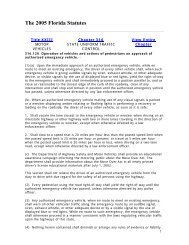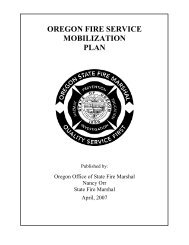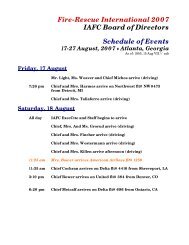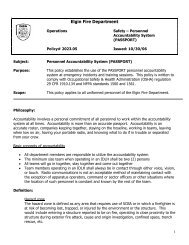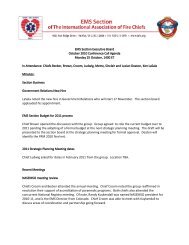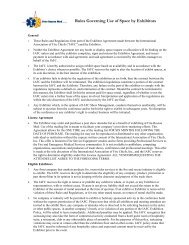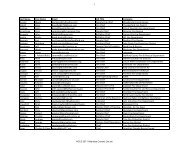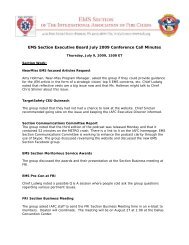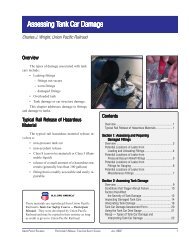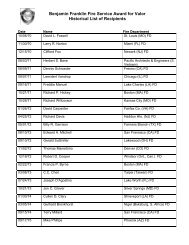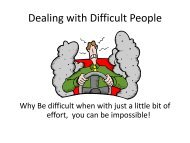Effects of Sleep Deprivation on Fire Fighters and EMS ... - NAEMT
Effects of Sleep Deprivation on Fire Fighters and EMS ... - NAEMT
Effects of Sleep Deprivation on Fire Fighters and EMS ... - NAEMT
Create successful ePaper yourself
Turn your PDF publications into a flip-book with our unique Google optimized e-Paper software.
<str<strong>on</strong>g>Effects</str<strong>on</strong>g> <str<strong>on</strong>g>of</str<strong>on</strong>g> <str<strong>on</strong>g>Sleep</str<strong>on</strong>g> <str<strong>on</strong>g>Deprivati<strong>on</strong></str<strong>on</strong>g> <strong>on</strong> <strong>Fire</strong> <strong>Fighters</strong> <strong>and</strong> <strong>EMS</strong> Resp<strong>on</strong>ders<br />
In general, the ability to adjust to night<br />
work <strong>and</strong> work l<strong>on</strong>g hours diminishes<br />
with aging (Reid & Daws<strong>on</strong>, 2001), <strong>and</strong><br />
some have proposed specific age limits<br />
for night <strong>and</strong>/or shift work (Baker et al.,<br />
2004). However, examinati<strong>on</strong> <str<strong>on</strong>g>of</str<strong>on</strong>g><br />
commercial driver crash risk as it relates<br />
to age, found the opposite findings.<br />
Older drivers were most likely to limit<br />
their exposure to risky driving situati<strong>on</strong>s,<br />
<strong>and</strong> age was not a predictor <str<strong>on</strong>g>of</str<strong>on</strong>g> job<br />
performance (Knipling et al., 2004).<br />
5.3 <str<strong>on</strong>g>Sleep</str<strong>on</strong>g> Habits <strong>and</strong> Lifestyles<br />
Workers’ ability to tolerate l<strong>on</strong>g hours is<br />
affected by their general health <strong>and</strong> how<br />
they spend their n<strong>on</strong>-working hours. Shift<br />
work may be a risk factor for a number <str<strong>on</strong>g>of</str<strong>on</strong>g><br />
health harming effects (Secti<strong>on</strong> 1). To<br />
counter those effects, maintaining a<br />
healthy lifestyle <strong>and</strong> achieving the<br />
Healthy People 2010 objectives is<br />
especially important (Table 5.3, next<br />
page). Those health behaviors are known<br />
to result in an increased life expectancy<br />
<strong>and</strong> improved quality <str<strong>on</strong>g>of</str<strong>on</strong>g> life (DHHS,<br />
2005).<br />
For shift workers, first am<strong>on</strong>g those lifestyle<br />
issues is their sleep habits. In general, adverse effects <str<strong>on</strong>g>of</str<strong>on</strong>g> irregular shift schedules <strong>and</strong> l<strong>on</strong>g work<br />
hours are minimized when people establish some regularity in their bedtime <strong>and</strong> waking schedule,<br />
even <strong>on</strong> weekends, so that an anchor <str<strong>on</strong>g>of</str<strong>on</strong>g> fixed sleeping times is maintained.<br />
As described in Secti<strong>on</strong> 1, all sleep hours are not equal, daytime sleeping is more difficult, <strong>and</strong><br />
those hours are not as restorative as nighttime sleeping. Shift workers who are up during the<br />
night are encouraged to develop good sleep hygiene practices<br />
to facilitate falling asleep during the day, after their work ends<br />
early in the morning. A light meal should be eaten before bed<br />
if the pers<strong>on</strong> is hungry. Breakfast foods such as toast, bagels or<br />
cereal are recommended. Caffeinated <strong>and</strong> alcoholic beverages<br />
should not be c<strong>on</strong>sumed before going to bed. Because bright<br />
sun light can heighten the normal tendency for daytime alertness<br />
<strong>and</strong> make it more difficult to sleep, individuals intending to<br />
sleep after arriving home <str<strong>on</strong>g>of</str<strong>on</strong>g>ten are advised to wear sun glasses<br />
when traveling home.<br />
Table 5.2. Early Bird or Night Owl Preference<br />
Answer 1=never, 3=sometimes or 5=always,<br />
<strong>and</strong> total your score.<br />
_____ I have a good appetite 20 minutes after waking in the<br />
morning.<br />
_____ I would have a great workout from 7 to 8 AM<br />
_____ I find it easy to get out <str<strong>on</strong>g>of</str<strong>on</strong>g> bed in the mornings.<br />
_____ I wake up without an alarm clock <strong>on</strong> workdays.<br />
_____ If I worked 4 AM to 6 AM, I would sleep before rather<br />
than after.<br />
_____ I am at my very best when I start my day.<br />
_____ If I had to take an important test, I would prefer to take it<br />
at: 8-10 AM (5 pts), 3-5 PM (3 pts), 7-9 PM (1 pt).<br />
_____ If I could choose my schedule, my core working hours<br />
would be: 5-10 AM (5 pts), 10 AM-3 PM (3 pts),<br />
5-10 PM (1 pt).<br />
_____ TOTAL (compare to the scale below)<br />
35-40 Extreme Early Bird: Am<strong>on</strong>g the 10 percent who<br />
naturally are early risers, are most productive during<br />
the first half <str<strong>on</strong>g>of</str<strong>on</strong>g> your day <strong>and</strong> <str<strong>on</strong>g>of</str<strong>on</strong>g>ten fade beginning<br />
mid afterno<strong>on</strong>.<br />
27-34 Moderate Early Bird: Still set your alarm clock or sleep<br />
in <strong>on</strong> days <str<strong>on</strong>g>of</str<strong>on</strong>g>f. Nights are not <str<strong>on</strong>g>of</str<strong>on</strong>g>f limits, but you d<strong>on</strong>’t<br />
<str<strong>on</strong>g>of</str<strong>on</strong>g>ten stay out late.<br />
22-26 Hummingbird: Flexible <strong>and</strong> tend to be ready for acti<strong>on</strong><br />
both morning <strong>and</strong> night.<br />
14-21 Moderate Owl: Prefer evenings. Your mood increases<br />
throughout the day.<br />
8-13 Definite Owl: You skip breakfast <strong>and</strong> arrive at work at<br />
the last minute. At night you find yourself busy, perhaps<br />
surfing the Internet, doing the laundry or socializing.<br />
Healthy People 2010 is a<br />
statement <str<strong>on</strong>g>of</str<strong>on</strong>g> U.S. health objectives<br />
designed to identify the<br />
most significant preventable<br />
health threats <strong>and</strong> establish<br />
nati<strong>on</strong>al goals to reduce those<br />
threats. It is available at<br />
www.healthypeople.gov/.<br />
61



